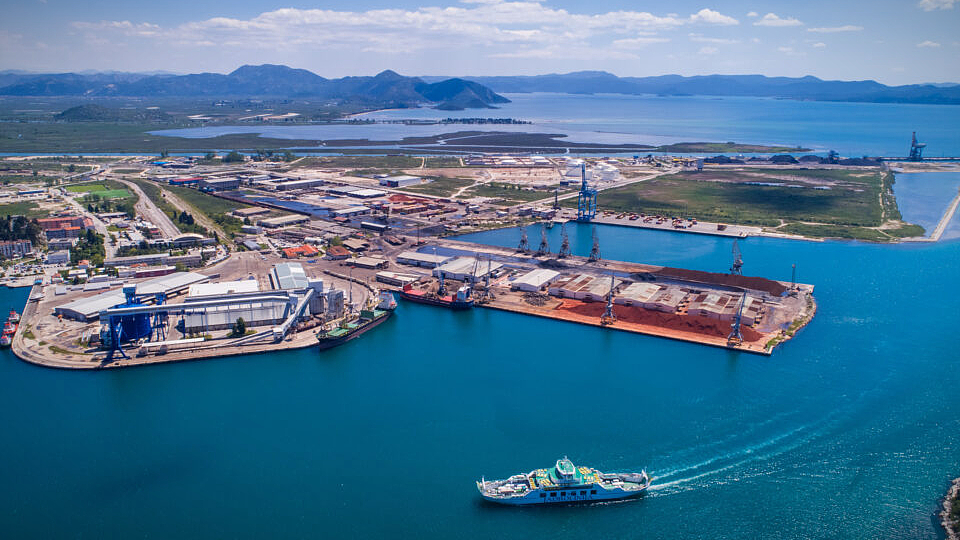A smorgasbord of new (and quite new) private 5G projects, including with the biggest coal producer in India, the second biggest cargo port in Croatia, and a little stretch of rural rail in the British shires. All good stuff, and further proof of the developing momentum and wild variety around this technology.
Mining in India – local startup Tidal Wave and Ireland-based Druid Software have installed private 5G for Coal India, the largest state-owned coal producer in the world; Tidal Wave has big plans with its own home-grown RAN system.
Shipping in Croatia – the port of Ploče, the second largest cargo port in Croatia, has appointed Atos Group subsidiary Eviden to deploy private 5G to underpin the port’s industrial IoT and AI applications.
Transport in the UK – rail connectivity specialist Icomera and network vendor Airspan have proved the viability of private 5G for a regional rail project in the UK to support passenger comms, and sundry on-board sensors and video.
Private 5G at Coal India, India

Indian private cellular startup Tidal Wave has deployed a private 5G system for Kolkata-headquartered Coal India, the largest government-owned coal producer in the world. Ireland-based Druid Software has supplied the private 5G core network components; the radio access network (RAN) is home-made, by Tidal Wave. The setup uses a local tranche of licensed spectrum from operator BSNL. Coal India supplies 80 percent of the total coal production in India.
Tidal Wave said it “partners with spectrum owners in respective regions”. As yet, the Indian government has not made 5G spectrum available directly to enterprises – as per the mid-band carve-ups for enterprises in Europe, the US, and elsewhere. The country’s department of telecommunications (DoT) is currently polling large enterprises in the country to assess demand for directly-licensed spectrum; the consultation period ends today (July 31).
Ankit Dixit, founder and chief executive at Tidal Wave, said the project with Coal India “exemplifies the ‘homegrown tidal wave’ of innovation in India’s telecom sector”. The Coal India deployments are at unspecified locations. Coal India has 430 coal mines (175 open pit mines, 227 underground mines, 28 mixed mines). It also owns subsidiaries in Africa. The company’s private 5G RAN system works in “multiple bands including for the CBRS”, it said.
It is unclear if it is selling outside of India yet, but it claims “field experience across multiple verticals, not just mining”. These other sectors include the ports, manufacturing, and defence sectors. “The strategy is to be laser focused on private networks [and to] perform customisations rapidly for… multiple use cases – with visible outcomes,” it said. A video of the Coal India project is available here; the setup includes 5G-based sensors, cameras, and drones.
Tidal Wave also sells via system integrators in India.
Druid Software said in a statement: “This collaboration highlights the power of innovation and international expertise in driving digital transformation within the Indian public sector… This deployment will enable critical applications, enhance operational efficiency, and improve safety for personnel working in challenging environments…. [It shows] the growing momentum of indigenous technology in India, amplified by strategic international partnerships. “
Ankit Dixit, founder and chief executive at Tidal Wave, said the project “exemplifies the ‘homegrown tidal wave’ of innovation in India’s telecom sector”. He said: “We are proud to contribute our expertise in building and deploying advanced network infrastructure to support this critical digital transformation initiative.” Dixit said in an interview recently with The Economic Times that Tidal Wave is in talks with other public sector firms about private 5G.
In another interview with Maritime Gateway, Dixit said: “Our primary customers include port authorities, terminal operators, and large public sector entities – particularly Maharatna companies – along with clients in mining, manufacturing, defense, and railways. We are deeply focused on customizing our 5G solutions to meet the evolving needs of these sectors. This involves continuous R&D, staying ahead of the curve on 5G advancements, and working hand-in-hand with our clients to co-develop features that solve their operational pain points.
“Tidal Wave is the only indigenous player with a field-proven private 5G network in India, a distinction that has been instrumental in earning trust and traction across multiple sectors… We’ve seen strong early adoption in verticals like mining, manufacturing, and logistics – particularly in states with major ports and industrial infrastructure. These sectors are increasingly investing in automation and intelligent operations, and our solutions have proven to be a natural fit.”
Private 5G at Port of Ploče, Croatia

The port of Ploče in Croatia has appointed Eviden, the industrial computing division of French system integrator Atos Group, to deploy a private 5G network to underpin its developing ‘smart-port’ project in support of new industrial IoT and AI applications. The port is the second largest cargo port in Croatia – after the Port of Rijeka. It handles about 4.5 million tonnes of cargo per year, operating as a critical logistics hub in central and southeastern Europe.
A statement said the “dedicated 5G network” will enable “seamless, real-time connectivity” across its port operations. The project is being delivered by Eviden in collaboration with local partner Markoja, an industrial comms integrator. There is no word on the network vendor partner/s. Eviden will provide the private 5G system under its Lifelink brand, which includes a bunch of IoT sensing and AI sense-making capabilities.
These are listed as: a real-time location system (RTLS) for tracking ships and vehicles, and managing traffic and access within the port area; a cargo monitoring system comprising ‘vision AI’ cameras and sensors for automated cargo identification and analytics; separate thermal cameras, fire sensors, and air and sea quality measurement sensors, along with a local weather station; 5G drone surveillance for further cargo and infrastructure monitoring.
Lifelink is geared for “mission-critical environments”, said Eviden, citing its high security, resiliency, and performance, as well as its “integration with IoT, AI, and edge computing, [and] custom engineering for complex operational landscapes”. Eviden said it has deployed the solution in the defense, energy, and utilities sectors, and that the project at Ploče “now leads [it] to expand into large-scale infrastructure projects in the transport and manufacturing sectors.”
Tomislav Batur, director of the Port of Ploče Authority, commented: “We will significantly enhance and digitalize processes within the port area. This will ultimately enable better traffic management, increase efficiency in the transport of goods and passengers, improve safety in cargo transport and port operations, and reduce pollution.”
Private 5G on East West Rail, UK

Swedish rail connectivity specialist Icomera has been engaged in a three-week trial at an automotive test track in the UK to show that private 5G will work for a 33 kilometre stretch of railway between Bicester and Bletchley, in Oxfordshire and Buckinghamshire. The project is part of the UK government’s England’s Connected Heartlands (ECH) project, intended to improve connectivity – logistical (transport), industrial (manufacturing), digital (comms) – in the country’s southern shires (Berkshire, Buckinghamshire, Bedfordshire, Cambridgeshire, Oxfordshire).
The testing finished last month (on June 16), when Icomera was joined at Millbrook Proving Ground by Oxfordshire County Council, along with system integrator AWTG and network vendor Airspan. Icomera stated: “The objective [was] to prove that a standalone private 5G (5G SA) network, destined for the Bicester–Bletchley stretch of East West Rail (EWR), could deliver the bandwidth and resilience needed for a truly digital railway.” It worked, apparently – showing the “performance potential and capacity benefits of private 5G in high-speed rail environments”.
The story goes like this: Icomera turning a “test track into a rail laboratory” by setting up a scaled-down private 5G network, comprising an Airspan radio and an Icomera core, along a one-mile straight at the Millbrook test track; an electric vehicle acted as a train carriage, fitted with train-top antennas and an Icomera (“rail-certified”) router. This replicated the speed of travel and connectivity setup of a modern train, it said. Its own proprietary SureWAN core technology, which aggregates connectivity across cellular and non-cellular networks, also worked well, it said.
Icomera said: “Just as EWR aims to support the shift in travel habits towards sustainable mobility by offering an alternative to car travel… the Millbrook campaign kept emissions to a minimum… logging more than 650 miles of zero-emission high-speed runs. The system maintained throughput above 500 Mbps – nearly an order of magnitude higher than the typical public network on UK trains today, with Icomera’s SureWAN link protocol managing the aggregation handover between each private 5G network tower, as well the available public, and satellite networks.”
It added: “If the bandwidth is available – along the track, over the horizon, in orbit – Icomera can aggregate it and deliver it to every device on board.” In sum, the tests showed private 5G delivered for high-speed rail internet access for passengers and onboard digital systems, including video surveillance, remote condition monitoring, EPOS, and crew communications. Such a setup could also improve digital inclusivity for people living and working alongside the rail line. There are 16,000 properties in the scope of the project, it said.
Icomera said: “While the ECH solution is not suitable for every UK railway, it will suit the EWR route, and the solution is ready to scale across similar regional and national corridors. Initially, the project will connect six C196 trains with the new 5G network, which are currently relying solely on public 4G networks. By building a scalable and future-proof infrastructure, the project supports a more connected, equitable, and digitally enabled transport network, laying the groundwork for smarter, more inclusive mobility across the region.”

